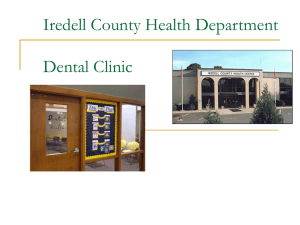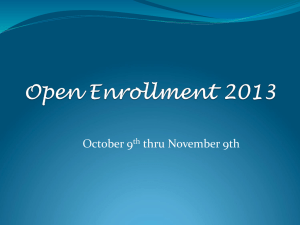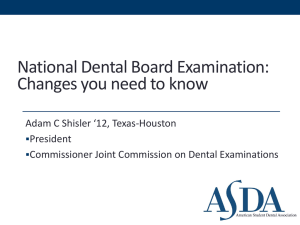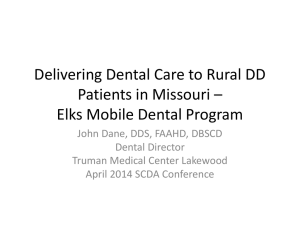Oral Health Colorado
advertisement
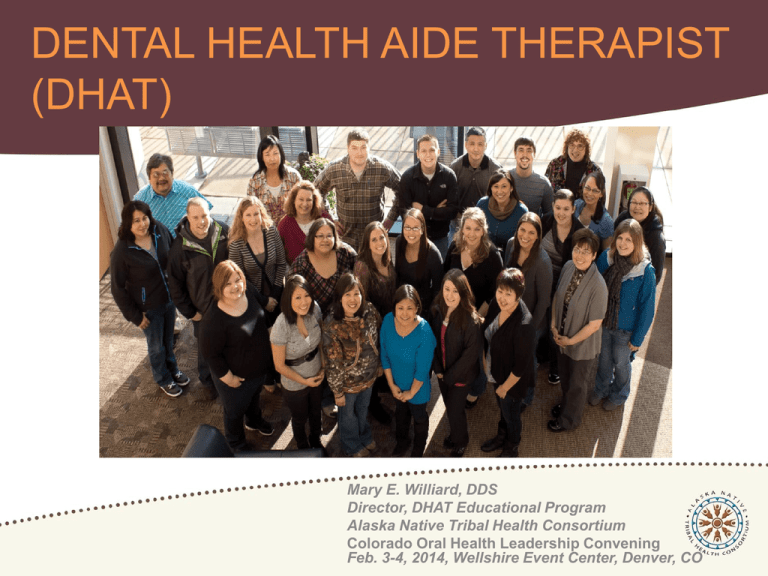
DENTAL HEALTH AIDE THERAPIST (DHAT) Mary E. Williard, DDS Director, DHAT Educational Program Alaska Native Tribal Health Consortium Colorado Oral Health Leadership Convening Feb. 3-4, 2014, Wellshire Event Center, Denver, CO Dental Access Issues in the U.S. • 5.3 million additional children will gain public insurance coverage under ACA. • Pew Center on the States, 2014 • Many dentists don’t treat Medicaid or to uninsured children • Nearly 52 million school hours are lost annually because of childhood dental disease 2013 Dental Hygiene Therapy.co.uk History of Dental Caries Among Alaska Native People Archeological records show caries rate of ~1% Improved air transportation and dietary changes 1928 – 1930’s 1984 1999 1925 Studies show lowest caries rate in the world Price, WA. 1939. Nutrition and Physical Degeneration. 8th ed. Lemon Grove, CA. Prevalence of dental caries in children 2x same aged U.S. children Vast majority of children have dental caries Dental Therapists: A Definition • Primary oral health care professionals • Basic clinical dental treatment and preventive services • Multidisciplinary team members • Advocate for the needs of clients • Refer for services beyond the scope of the dental therapist’s practice.* *SASKATCHEWAN DENTAL THERAPISTS ASSOCIATION “A Review of the Global Literature on Dental Therapists”* • • • • • Dental therapists included in the oral health workforce have the potential to decrease the cost of care, specifically for children. There are variable lengths of training for dental therapists, from two to four years, with two years being the tradition. Dental therapists improve access to care, specifically for children. Dental therapists have a record of providing oral health care safely. The public values the role of dental therapists in the oral health workforce. *Prepared by: David A. Nash, Jay W. Friedman, Kavita R. Mathu-Muju, Peter G. Robinson, Julie Satur, Susan Moffat, Rosemary Kardos, Edward C.M. Lo, Anthony H.H. Wong, Nasruddin Jaafar, Jos van den Heuvel, Prathip Phantumvanit, Eu Oy Chu, Rahul Naidu, Lesley Naidoo, Irving McKenzie and Eshani Fernando Supported by the W.K. Kellogg Foundation http://www.wkkf.org/news-and-media/article/2012/04/nash-report-is-evidence-that-dental-therapists-expandaccess Curriculum Developed • 11-person academic panel • Model curriculum is based on a twoyear, post-secondary training program. Special Issue: Workforce Development in Dentistry: Addressing Access to Care Spring 2011 Volume 71, Issue Supplement s2 Dental Therapy Education Standards • Community Catalyst Panel of experts DT Educators Dental Therapists Dentist Supervisors • Commission on Dental Accreditation Draft Requires 3 years & baccalaureate DHAT 2-year Education No Prerequisites Conan Murat, DHAT, standing his ground Community Health Aide Program Structure • Community Health Aide Program Certification Board • Federally appointed • Diverse group (MD, DDS, RN, PA, CHAP) • Standards and Procedures • Educational requirements • Certification process • Scope of practice • Operated by the Alaska Tribal Health System CHAP CB Standards and Procedures http://www.akchap.org Click on: “CHAP Certification Board Library Page” DHAT Education • NEED TO KNOW • Limited scopes • Use same texts as dental schools • Supervision • Prevention oriented team approach • Accessible to student in target populations • Cultural Competence • Patient centered DHAT Curriculum Year 1: basic health sciences, basic dental concepts, professional role development, introduction to clinic, patient and facilities management. DHAT Students Kate Kohl, Trisha Patton dissecting a cow heart Year 2: clinical year, expansion of concepts learned in first year, extractions, community project, village dental rotations Alaska DHAT Educational Program information: First year: 40 weeks Second year: 39 weeks Total: 79 weeks (3160 hours) Curriculum Break-down first year Biological Science: 30% Social Science: 10% Curriculum Break-down second year Pre-clinic: 40% Biological Science: 15% Clinic: 20% Social Science: 7% Pre-clinic: 0% Clinic: 78% (1215 hours) Curriculum Break-down two years combined: Biological Science: 22.5% Social Science: 8.5% Pre-clinic: 20% (632 hours) Clinic: 49% (1548 hours) DHAT Scope of Practice Diagnosis and Treatment Planning, Prevention, Basic Hygiene, Radiographs, Infection Control, Restorative, Pediatric, Urgent Care, Extractions, Community Projects, Clinic Management, Equipment Repair and Maintenance, Referral Process DHAT, Ben Steward, examining patient • All ages • General Supervision • Part of a team of dental and medical providers Research Triangle Institute Clinical Evaluation • Summary of findings • Technically competent to perform procedures within their scope of practice • Providing care safely and appropriately under general supervision of dentists • Successfully treating cavities and helping relieve pain for patients without previous access to regular care • Patient satisfaction high • Well accepted in tribal villages From ANTHC Consultant Survey of AK Tribal Dental Directors 700 visits 500 visits Each DHAT team on average, provides care to 830 patients during approximately 1200 patient encounters (or visits) each year. Scott and Co. Consulting Tribal revenue as reported by dental directors with DHAT The net annual revenue stream generated by the employer is $125,000-$245,000 after costs (DHAT and dental assistant salary, benefits, travel, supplies, and other costs) with savings of ~$40,000 in avoided travel costs to receive dental care 19 DHATs generate 76 jobs (dental assistants, training program faculty, management, staff) with half of these jobs and the related $9m economic activity in rural Alaska Scott and Co. Consulting, 2011 Improved Access and Quality • 25 certified DHAT • 81 communities in rural AK • Over 40,000 people have access • Continuity of care • Higher level of care possible • Dentist working up to their licensure DHAT Aurora Johnson, NZ Educated DHA Supervision It Takes a Team Systems Insure Success • The “routine” of supervision (Different from DDS) • Starts in school • Solidified in preceptorship • Maintained in field • Formats for reports and consultation • HIPPA compliant communication systems DHAT Ben Steward in pre-clinical lab with mock Telehealth case on monitor Telehealth cart, Emmonak Subregional clinic DHA Certification • After coursework• preceptorship • Direct supervision • Standing orders• Limits for general supervision • Recertification• Every two years • CDE- 24 hours • Direct observation of all technical skills in scope. DHAT students Bernadette Charles and Tambre Guido with supervising dentist Edwin Allgair, 2010 Community-based DHAT as part of a dentist led team Dentist Supervisor Quotes About Working With DHAT Scott and Co. Consulting, 2011 “A more complete dental team” “A full time dental presence keeps oral health at the forefront year round” “Patients feel comfortable around her” “Community pride. Pride among the THO Board of Directors. Improved access to routine and preventive dental care” “Fewer emergencies for dental pain, and less time to treatment” Benefits of DHAT • Culturally competent • Stable workforce • Highly satisfied • Role models • Economic benefits DHAT students Elsie Patrick and Shannon Hardy practice head and neck physical examination techniques • Community pride Prevention and Promotion The Heart of DHAT Practice Community Projects Elder Oral Screenings DHAT student Sheena Nelson with instructor Kathy Balasko, RDH, and elder Head Start Oral Health Education ECC Education for CHAP & Medical Providers Demographics of the existing US dental workforce Dentists: 86% White 6.9% Asian/Pacific Islander 3.4 African American 3.4 Hispanic 0.2 American Indian *1 Dental hygienists: >90% non‐Hispanic white *2 * 1. Current Demographics and Future Trends of the Dentist Workforce, Institute of Medicine, The U.S. Oral Health Workforce in the Coming Decade: A Workshop February 9, 2009, Richard W. Valachovic, D.M.D., M.P.H., Executive Director, American Dental Education Association 2. Dental Hygiene at the Crossroads of Change, Environmental Scan 2011‐2021, Marsha Rhea and Craig Bettles. Who are your target students? “For some students, the only way to get into a health career is to take it a chunk at a time. Requiring a bachelor’s degree would make health careers inaccessible to many people,” said [Carolyn] O'Daniel, who is dean of allied health and nursing at Jefferson Community and Technical College in Kentucky. “Colleges worry about ‘degree creep’ in health care,” By Ellie Ashford, Published August 10, 2011. Community College Times, American Association of Community Colleges. DHAT Student and Practitioner Retention Rates •AK program 64% completion rate • US 2-year College completion rates ~29.1% •35 total graduates (NZ +AK) •29 DHAT practicing • 10 year retention rate 83% Happy customer Why DHAT Work So Well • Not Mini-Dentists • 2 year educational model • From communities they serve • General supervision • Ability to do extractions • Ability to diagnose • Certification recertification Trisha Patton, DHAT student, taking x-rays • Community based Degree Creep and Dental Therapy Politics 2 year DT are employable, Many RDH unemployed Barbara Jones, president of South Arkansas Community College (SouthArk) “Jones cited additional problems with degree creep in nursing: a lack of qualified faculty to teach baccalaureate programs, a decline in workforce diversity, deceased access to health care in rural areas, and a decline in job satisfaction and morale if health care workers feel their skills and knowledge are not fully used.”* *“Colleges worry about ‘degree creep’ in health care,” By Ellie Ashford, Published August 10, 2011. Community College Times, American Association of Community Colleges. DHAT Educational Program Address: 4200 Lake Otis Parkway, Ste 204 Anchorage, AK 99508 Mary E. Williard, DDS 907-729-5602 Sarah Shoffstall-Cone, DDS 907-729-5607 DHAT training is ANTHCsmile on Facebook and twitter website: http://anthc.org/chs/chap/dhs/ Div. of Community Health Services- DHAT education
